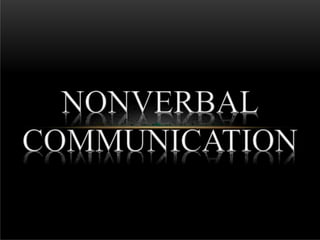
non verbal communication.pptx
- 2. WHAT IS NONVERBAL COMMUNICATION? • Nonverbal communication are those nonvocal symbols we often use unconsciously. • The nonverbal communication otherwise known as the “Silent Language”.
- 3. DIFFERENCES BETWEEN NONVERBAL AND VERBAL COMMUNICATION 1.Verbal communication includes one dimension while the nonverbal involves multi-dimensions (multichanneled). 2.Verbal is intermittent (alternating) while the nonverbal is continuous (nonstop). 3.Verbal is less subject to misinterpretation while nonverbal is more ambiguous (uncertain).
- 4. 4.Verbal has less impact when verbal and nonverbal cues are contradictory. 5.Verbal is usually deliberate while nonverbal is often unintentional. 6.Nonverbal gives more insight into emotional states. 7.Many types of nonverbal communication are recognized across cultures.
- 5. TYPES OF NONVERBAL COMMUNICATION 1. Body Motions - Gestures and Body Stance - Face and Eyes 2. Distance and Territory - Distance or space - Territory 3. Touch 4. Time 5. Paralanguage 6. Self-presentation
- 6. 1. BODY MOTIONS - Body motions include gestures, eye movement, facial expressions, and posture or body stance. - The field that studies such movements is termed Kinesics.
- 7. 1. BODY MOTIONS a. Gestures - Gestures include the movements of the parts of the upper torso, usually the hands. - Often carried out consciously, different hand gestures help emphasize meanings and regulate interaction between or among participants.
- 9. a. Body Stance - Body stance or posture also plays a crucial role in communication. - The way one carries his or her body and gestures. 1. BODY MOTIONS
- 10. b. Facial Expressions - Facial expressions also regulate interaction, as they provide feedback and manage the flow of the communication process. - The face displays numerous emotions. 1. BODY MOTIONS
- 12. b. Eye Movement - Eyes are said to be the window to the soul. - Through eye contact, one can tell if the other party is paying attention to the speaker’s words. - It can also help in determining whether one is saying the truth or not. - Through eye contact we can be able to know one’s emotional condition. 1. BODY MOTIONS
- 13. 2. DISTANCE AND TERRITORY a. Distance or Space - Used by people reveals the relationships that exist between and/or among them. - Generally, people use interpersonal or personal space. - Interpersonal/personal space is a space that takes place when individuals converge and diverge depending on the relationship of the participants, the communication encounter, and their personalities.
- 15. • Hall (1959, 1966) in Knapp and Hall, 2002, further categorizes interpersonal space into: - Intimate distance ranging from actual physical contact to about 18 inches (1.5 ft.); - Casual-personal (personal distance) that is approximately 1.5 ft. (18 inches) to 4 ft. (48 inches); - Social-consultative (social distance) for impersonal business ranging from 4 to 12 ft. (48 inches to 144 inches); and - Public distance which ranges from 12 ft. (144 inches) to the limits of visibility or hearing.
- 16. b. Territory - It tells how much space can a person expect to have (Buerkel-Rothfuss, 1985). - Territory can be public, interactional, or home territory. 2. DISTANCE AND TERRITORY
- 17. 1.Public territory – where the setting is open to anyone. 2.Interactional territory – space reserved for particular people during a specific time. 3.Home territory – where one can exert greatest control over personal space – the space which an individual lives and works.
- 18. 3. TOUCH -Touch may indicate sociability and willingness to participate in the communication process such as handshakes, friendship, love, etc. -The frequency of touch and range of touching behavior between persons indicate the intimacy of the relationship while the infrequency or absence of such may show a lack of intimacy in a relationship (Buerkel-Rothfuss, 1985).
- 19. 4. TIME - Time depends greatly on culture. - The way time is handled can express both intentional and unintentional messages. - The way time is used reveals important functions in communication.
- 20. 5. PARALANGUAGE - The attributes of voice like audibility, pleasantness, distinctness, and correctness in pronunciation, flexibility, etc. help shape the meaning in oral communication. - These attributes help in creating meaning. - Paralanguage goes beyond the linguistic form of an utterance.
- 21. - Diction, the highness and lowness of tone, intensity, the manner of delivery, rate of speaking, etc. create the intended meaning of an utterance. - When something is delivered coupled with gestures and facial expressions may reflect the feeling(s) and/or emotion(s) of the participant in a communicative situation.
- 22. 6. SELF-PRESENTATION - Physical appearance and attractiveness can also be powerful communicators, as they indicate status. - As Buerkel-Rothfuss (1985) states that in most cultures, physical appearance largely determines attractiveness and those who are attractive are more likely to be considered as more intelligent, more persuasive, and more likeable than the unattractive ones. - Self-presentation is also manifested through the objects used and/or worn by individuals. - Objects like clothing and jewelry can be a means to allow others to know attitudes, behaviors, and even status.
- 23. INFLUENCES ON NONVERBAL COMMUNICATION 1. Culture - Nonverbal languages are interpreted according to one’s culture which in some cases leads to conflict or misunderstanding among people.
- 24. a. Smile b. Thumbs Up c. “OK” sign d. Clapping e. Head Movements f. Pointing with forefinger g. Eye contact h. Handshake i. Passing an object with one hand or left hand j. Beckon with index finger k. “V” sign
- 25. 2. Gender - Gender plays a role in the way people communicate. - Men and women are noted to have differences in several aspects. INFLUENCES ON NONVERBAL COMMUNICATION
- 26. FUNCTIONS OF NONVERBAL COMMUNICATION 1. Repeat, complement and accent/moderate spoken words. - Nonverbal can repeat the verbal codes; complement, that is, to match the verbal messages; and accent/moderate, that is to emphasize the verbal message.
- 27. FUNCTIONS OF NONVERBAL COMMUNICATION 2. Substitute for speech. - Using nonverbal to substitute occurs when one does not use the verbal language.